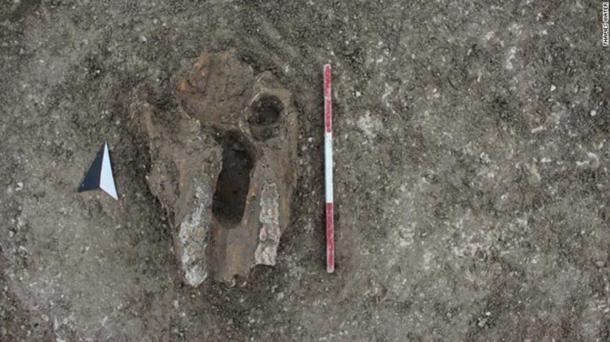Ancient Death Pit of Sacrificed and Butchered Humans Found in England
Sometimes archaeologists happen upon discoveries that are stark reminders to our animalistic past and such was the case last week in Oxfordshire, England.
A team of Thames Water engineers laying water pipes in a chalk stream were shocked to discover an ancient death pit of “dozens of human skeletons”, many of which show signs of having been brutally sacrificed almost 3,000 years ago.

Discovering the Ancient Death Pit
Archaeologists were immediately called in and they soon began excavating what turned out to be artifacts from an ancient Iron Age settlement .
A selection of tools and animal parts, including a horse’s skull, were recovered along with body parts from 26 individuals dating to the British Iron Age and Roman periods .
One person was found with their skull placed by their feet and a woman was discovered with her feet chopped off and her arms tied behind her head.

A CNN article quotes Paolo Guarino, Cotswold Archaeology project officer, who released a statement claiming that the team of archaeologists inspecting the human remains believe they were involved in creating England’s iconic ‘ Uffington White Horse’ , a vast prehistoric chalked geo-glyph located on a hill near the location where the bodies were recovered.
He said, “The results from the analysis of the artefacts, animal bones, the human skeletons and the soil samples will help us add some important information to the history of the communities that occupied these lands so many years ago.”
The White horse is a tribal symbol and archaeologist Joshua Pollard pointed out that the horse aligns with the midwinter sun, when it appears to overtake the horse, reflecting mythological beliefs that the sun was carried across the sky on a horse or in a chariot ; a motif known as the “ Solar Horse ” across ancient Europe.
And the recently unearthed remains of the people might also be evidence that they were sacrificed to assure the daily return of the Sun.

Human Sacrifice Wasn’t a Sport, It was Cultural
Neil Holbrook, chief executive of Cotswold Archaeology, told reporters in a statement “The discovery challenges our perceptions about the past, and invites us to try to understand the beliefs of people who lived and died more than 2,000 years ago.” And, according to Holbrook, the evidence “suggests that burials in pits might have involved human sacrifice .”
The archaeologists removed the remains from the site for deeper forensic investigation and hope to learn more about ‘the way’ in which people were sacrificed, which will lead to clearer understanding of ‘why’ it happened.
Way back in 2015 an Ancient Origins article titled, The practice of sacrifice in Iron Age Britain asked “How often were sacrifices made, for what reasons and what – or more interestingly, who – were sacrificed?”
All over the ancient world agricultural and fishing based communities made human sacrifices after floods, plagues, famines, earthquakes and landslides to improve their perceived favor with the gods, asking “for divine forgiveness or foresight, or to apologize for an event or task that might have angered them.” Alternatively, sacrifices were made to assure bountiful harvests and success in impending territorial battles and wars.

More Evidence for Ritualized Murder
While the recently discovered bodies were sacrificed 3000 years ago, there is an abundance of evidence for ritualized murder in Britain happening as far back as 5000 years ago.
A 2015 Daily Mail feature discusses findings in Wiltshire, the home of the famous Stonehenge stone circle. Archaeologists discovered that thousands of ancient people stood along great earthen walls surrounding an oval-shaped arena situated in Salisbury Plain and beneath these mounds were thousands of animal bones that had been sacrificed and eaten in huge feasts.
Archaeologists told reporters at the Mail that “When you dig in these areas, you often find pits with animal remains in them. Because the skeletons are intact or in large ‘chunks’, they were probably killed not to be eaten, but as some kind of offering to the gods and the bones suggest pigs were the animal of choice for eating, feasting and sacrificing in the Neolithic period, from 4000 BC to 2500 BC.”

But the archaeologists in Wiltshire also “found humans with arrowheads embedded between vertebrae, and head injuries. They died violently and possibly in sacrifice.”
In contrast to medieval warriors who fell on battlefields and were buried in large groups, ancient bodies are more often found buried individually and within larger, custom built monuments, which suggests they were sacrificed in a religious ceremony.
As ancient hunter gatherers emerged from the wild wooded landscapes of Britain, throwing down their spears for farm tools, and began crafting England’s green fields, it would appear that everything possible was undertaken to assure agricultural success, including lopping the feet off of a woman, according to this new evidence. Ladies, you should be really thankful for pesticides and tractors!
